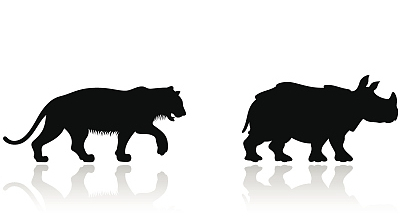
Wildlife
21:09, 30-Oct-2018
China allows regulated trade of rhino horns and tiger products
Updated
21:03, 02-Nov-2018
By Alok Gupta

In a major policy change, China on Monday legalized regulated trade of rhino horns and tiger products for medicinal use as well as for scientific and cultural purposes. The decision has gained global attention from conservationists and the scientific community.
Rhino horns and tiger bones used in medical research or healing can only be obtained from farmed rhinos and tigers, not including those raised in zoos, a circular issued by State Council on Monday said.
"Powdered forms of rhino horn and bones from dead tigers can only be used in qualified hospitals by qualified doctors recognized by the State Administration of Traditional Chinese Medicine,” it added.
The policy change adapts China's wildlife law enforced in 1993 that banned international trade of rhino and tiger parts.
According to the circular, “Except in special circumstances prescribed by law, the country bans all actions involving sales, purchase, use and import or export of rhinoceros, tigers and their related products, including the whole body, parts of it or any derived products.”

China on Monday legalized regulated trade of rhino horn and tiger products for medicinal use, and scientific and cultural purposes. /VCG Photo
China on Monday legalized regulated trade of rhino horn and tiger products for medicinal use, and scientific and cultural purposes. /VCG Photo
In a statement, the Ministry of Foreign Affairs (MOFA) maintained that the recent policy change aligns with the regulation formulated in 1993 to ban the international rhino trade.
"Previous regulation did not take into account scientific research, education, and law enforcement verification, animal conservation and other current realities into consideration,” a MOFA spokesperson said.
The policy adjustment sticks to the principles of protection as the top priority, standard use of laws, and also takes into account the positive and negative effects of the protection of global rhino and tiger populations, MOFA added. “China has formulated a series of strict supervision measures and established a joint law enforcement coordination mechanism for wildlife protection.”
There are some crucial aspects which do not seem to have changed in the recent policy modification. WildAid CEO, Peter Knight, told CGTN that the policy announcement does not mention importing or exporting rhino horn or tiger parts, which would violate the CITES directive that bans international trade of rhino and tiger parts.
According to the Environmental Investigation Agency (EIA), there are more than 7,000 captive tigers in China, Thailand, Laos, Vietnam, and South Africa.
In China, more than 150 companies have permits to sell tiger parts from animals dying in captivity.
Many observers think the real effects of the announcement might be felt less in the wild and more on the “agriculture” of farming wild animals. “We surmise that Chinese tiger farms could be the ultimate beneficiary,” Knight said.
"If this new policy ends in commercial sales and plays out similarly to when ivory was legalized, poaching will skyrocket as traders look to increased demand and the ability to launder rhino horn,” he added.
Apart from the regulated use of rhino horn and tiger parts, the State Council has authorized the Ministry of Culture and Tourism and the State Administration of Cultural Heritage for sales, import, and export of wildlife products that are classified as cultural relics.
Both ministries will also be responsible for the transportation of relics for cultural exchanges.
(Top image via VCG)

SITEMAP
Copyright © 2018 CGTN. Beijing ICP prepared NO.16065310-3
Copyright © 2018 CGTN. Beijing ICP prepared NO.16065310-3